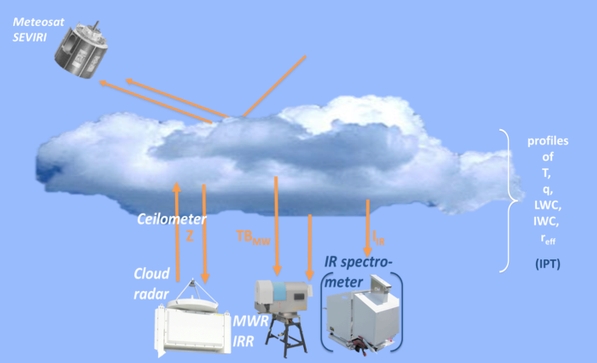
Fig.1 : Scheme of ICOS (K. Ebell)

Retrieval of physical cloud properties
The combination of ground observations with satellite data improves the understanding of cloud processes.
Cloud processes remain one of the largest challenges in atmospheric research partly due to a gap in statistically significant observations of cloud macro- and microphysical properties. The most detailed and continuous observations available today come from the combination of state-of-the-art ground-based sensors at a few “super sites” worldwide. In order to derive the atmospheric state from all measurement information, sophisticated retrieval techniques need to be developed. The measurements have been extended by incorporating satellite observations by Meteosat SEVIRI into the framework for the additional retrieval of cloud microphysics (effective radius, optical thickness) and cloud radiation budget. In addition, SEVIRI measurements will be exploited to provide auxiliary information on a) the history of the cloud observed at the super site (life time, microphysical development, environment) and b) the representativeness of the cloud for the cloud field around the site. The method will be developed on the basis of existing data sets from observation sites at Lindenberg, Jülich, and Leipzig. Objective
Determine the temporal evolution (history) of the air mass which transports the cloud observed by ground-based observations as a new parameter in cloud observation.
Assess the spatial representativeness of ground-based column observations (upscaling).

Fig.1 : Scheme of ICOS (K. Ebell)
Investigation of the adiabatic assumption for estimating cloud micro- and macrophysical properties from satellite and ground observations
Further, our aim is to investigate the accuracy of current satellite retrievals by contrasting the key quantities with those obtained from ground-site. Therefore an optimal estimation tool has been developed to retrieve the cloud droplet number concentration as well as the liquid water content profile based on the radar reflectivity profile and the liquid water path. These make it possible to compare the retrieved quantities from ground with the satellite perspective and to improve the general assumption of adiabatic cloud profiles.
References
Merk, D., Deneke, H., Pospichal, B., Seifert, P(2016): Investigation of the adiabatic assumption for estimating cloud micro- and macrophysical properties from satellite and ground observations Atmos. Chem. Phys., 16, 933-952 p.,doi:10.5194/acp-16-933-2016
Hünerbein, A., Deneke, H., Macke, A., Ebell, K., Görsdorf, U. (2014): Combining satellite- and ground-based observations to analyze cloud frontal systems J. Appl. Meteorol. Clim., 53, 2538-2552 p. doi:10.1175/JAMC-D-13-0274.1